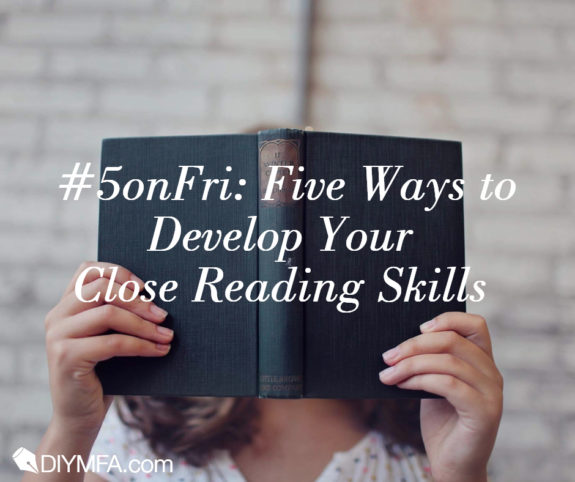Stephen King told us, “If you don’t have time to read, you don’t have the time (or the tools) to write. Simple as that.” But merely reading isn’t enough. Close reading is necessary to learn the secrets of how stories tick, which will help you sharpen those writing tools Stephen King mentioned.
First we need a shift in mindset to read not as a reader, but as a writer, evaluating the story as we go and actively engaging with it. Then we need a strategy, a way to peel open the story to uncover its inner workings, the way a mechanic would check under a car’s hood. We’ll be asking a lot of questions about how the author approaches storytelling, and we’ll come up with answers about whether we think those choices are successful. This process works for almost any genre or format: novel or short story, fiction or narrative nonfiction, fantasy or young adult. What’s most important here is the method.
Let me take a moment to ease a concern many writers have about close reading. The goal isn’t to arrive at the same opinion about a book. Your reactions to the author’s storytelling techniques are valid and you get to decide whether you want to make those same choices in your own story. Some writers are worried that this approach will take all of the fun out of reading books. I promise that you will still be swept away by a good book, just as you’ll still be bored by a bad one, but by asking yourself these questions, you’ll have a keen understanding of why.
1) Note your initial reaction
When you read the opening pages, consider the overall tone. (Suspicious? Conversational? Sarcastic? Irreverent?) What word choices does the author use to convey this tone? Now ask yourself a few simple questions:
- Has the main character(s) been introduced? Do you care enough about the character to spend the next three hundred pages with her?
- Do you have a sense of what the story will be about? Is it building toward something important? Are you curious enough to keep reading? What, exactly, has piqued your curiosity?
2) Gain the big picture
As you’re reading, stop at least once per chapter and ask yourself:
- What happened in this chapter? In other words, what actions are the characters doing to move the story forward?
- Are the main characters compelling? What do you find interesting about them?
- Are you enjoying the story? Do you want to keep reading? Or are you forcing yourself to return to the book?
- Does the world the characters inhabit reflect their situation?
- Do you notice any patterns such as repetition of an image?
3) Put yourself in this author’s shoes
Often an author’s choices are influenced by the story’s genre. Many genres have certain conventions, especially with plot progression, that readers have come to expect (and love). Beyond that, the other story elements are fair game.
- Does the author have control over the story?
- Is the pacing consistent with the action?
- Does the story seem to unfold in a haphazard way?
- What would you do differently if you were writing this book?
4) Consider the characters
Turn your attention to the area that can make or break a story: character development. As you’re reading, be on the lookout for these important points:
- In most stories, though not all genres, the main character undergoes a change as a result of the events of the story. When do you notice the main character begin to shift? How do you know? Watch for different word choices and thought patterns.
- It should be apparent early on what is at stake for the main character. At what point in the story do you understand what’s at stake? (Bonus if it is clear from the first few pages!) Why does the character have this goal and why does it matter to her? Do the stakes ever increase?
- Do any supporting characters feel like cardboard characters? If so, identify areas in the story where there are opportunities to add details that would help these characters reach their potential.
5) Ask why
This is the single biggest thing you can do to bring the techniques of what you’re reading into your own writing. When you read a paragraph or a scene that resonates with you, stop. Dig a bit deeper by asking yourself why. Why do you find this passage so compelling? Why do you think the author made this choice? Why does this scene feel so suspenseful? Why do you like (or not like) this character? Don’t let yourself off the hook with a generic answer. Keep asking why until you get to the specific technique the author used.
As you practice reading like a writer, these questions will become second nature. You’ll consider your reaction to the story elements and dive a bit deeper to determine if the author’s storytelling techniques worked for you. Before you know it, you’ll be incorporating these methods in your own story.
 Jacquelin Cangro is a book editor, creative writing instructor, and writing coach with 20 years of experience at Penguin Random House. She helps writers develop the confidence and skills they need to get their stories on the page. Visit her site to find many resources to improve your writing, including her new free program, How to Read Like a Writer. Find her on Instagram @jcangro and in her Facebook group.
Jacquelin Cangro is a book editor, creative writing instructor, and writing coach with 20 years of experience at Penguin Random House. She helps writers develop the confidence and skills they need to get their stories on the page. Visit her site to find many resources to improve your writing, including her new free program, How to Read Like a Writer. Find her on Instagram @jcangro and in her Facebook group.







